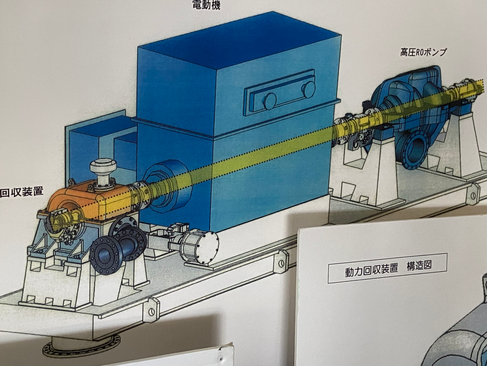Converts Seawater to Fresh Water
- OCI Office

- Apr 12
- 4 min read
Updated: May 13
On April 4, 2025, two OCI members went to visit the Seawater Desalination Center, also known as “Mamizu Pia” located in Higashi Ward, Fukuoka City.
The “Mamizu Pia” started operation in 2005 as part of efforts to secure water resources for the Fukuoka metropolitan area. It is the largest facility in Japan that supplies tap water by desalinating seawater and is located in Umi-no-Nakamichi, facing the Genkai Sea on one side and Fukuoka Bay on the other.
First, let's start with an overview of the facility.
・Location: 1302-122 Oaza Nata, Higashi-ku, Fukuoka City, Fukuoka Prefecture
・Site area: Approximately 46,000 square meters
・Maximum water intake: 103,000 cubic meters/day
・Maximum production capacity: 50,000 cubic meters/day (equivalent to tap water for approximately 250,000 people)
Seawater Desalination Center (Mamizu Pia)

The background for the establishment of this facility was the serious drought problem that occurred in Fukuoka City in 1978. Since there was no suitable place in Fukuoka to build a dam and there were no large rivers, a unique approach to water resources was considered: converting seawater into fresh water. Twenty years after the facility went into operation, it has become an indispensable water source for local residents.
One of the world's challenges is also this water problem. Although there is a lot of water on the water planet Earth, it is said that only 0.8% of it can be used as drinking water, and “seawater becomes fresh water!“ Desalination technology will play a very important role in the future.
On the day of the event, we were given a detailed tour of the process of turning seawater into fresh water, and we would like to share what we learned.
◾️Water Intake Methods
The first process is water intake. The intake facility is located in the Genkai Sea, approximately 640m offshore from the coastline at a water depth of approximately 12m. The intake system uses permeable pipes buried in the seabed to ensure stable intake of clean seawater. The “seepage intake method” is a method in which holes are dug in the seafloor and a layer of sand and stones of different sizes is constructed to collect seawater that has seeped into the sand layer. As of April 2025, Mamizu Pia is the only facility in the world that uses this method, and seawater is said to enter the intake pipe at a rate of about 6 m per day.
👍This place is great!
・Stable supply of clean seawater regardless of the conditions in the sea area.・Fish eggs and fry are not sucked into the water, so there is little impact on the biological environment.
・Since attached organisms are also filtered out, there is no need to clean the pipelines, add chemicals, or take into account the amount of attached organisms.。
◾️About the Desalination Process
1. Pretreatment
A process using an ultrafiltration membrane (UF membrane) was included in the initial operation to remove microorganisms and fine particles. However, it was found that seawater with a high degree of cleanliness could be obtained at the point of intake, and a one-year test was conducted to omit UF membranes. As a result, it was determined that the filtration process using UF membranes was unnecessary, and they are no longer used.
👍This place is great!
・The engineers' diligent attention to detail and their techniques, down to the stones and sand they used, resulted in a high degree of accuracy in water intake and eliminated the need for UF membranes. (From the story at the time of construction)
・The cost of membrane replacement and other costs were reduced.
2. Desalination treatment
This process separates freshwater from seawater using high-pressure reverse osmosis (RO)
membranes. A high-pressure RO pump applies high pressure to the seawater and sends it to the high-pressure RO membrane, which collects 60% of the freshwater from the seawater. The remaining 40% concentrated seawater is mixed with treated water from a sewage treatment plant and discharged into Hakata Bay.
👍This place is great!
・Since ordinary treated sewage water is discharged into Hakata Bay, the salinity of the sea tended to be diluted, but by mixing the treated water with concentrated seawater, the salinity of the seawater was successfully adjusted. However, by mixing the treated water with concentrated seawater, the salinity of the seawater was successfully adjusted. This caused the tides to flow, further improving the fishing environment.
・In order to reduce the electricity required by the high-pressure RO pumps, the pressure energy remaining in the concentrated seawater is reused.
3. Water quality control
Water quality is further improved through low-pressure RO membranes to produce high- quality water with less than 200 mg/L of evaporation residue. The produced water here is stored in a production tank and sent to each mixing facility by a conduit pump.
👍This place is great!
The amount of low-pressure RO membrane treatment is adjusted according to water quality conditions and conditions so that the water quality is always the same.
◾️About Produced Water
At the end of the tour, we were allowed to compare the produced water with tap water in Fukuoka City. Produced water loses all flavor components and minerals, so at each mixing facility where produced water is sent, the water is mixed with water from the water purification plant and then delivered to each household with added flavor and minerals. The difference was obvious when we drank the water. Produced water supports this as the water of life and life. The central monitoring and control room is staffed by several people who monitor and watch over this facility day and night throughout the year, without a break. The taste of the water, which has been transformed from seawater to fresh water, is the fruit of the solid technology and the passion of everyone involved, and I was very impressed by the taste.
◾️Finally
"Mamizu Pia” is a facility that symbolizes the advanced efforts in securing water resources in the Fukuoka metropolitan area. In particular, the environmental friendliness and the introduction of highly efficient desalination technology are worthy of attention as a model case for other regions. I was particularly surprised to learn that the water intake facility used at Mamizu Pia has required no maintenance since its construction. I thought this was the result of a successful combination of the marine environment of the Genkai Sea, the power of nature, and meticulous technology.







































Comments